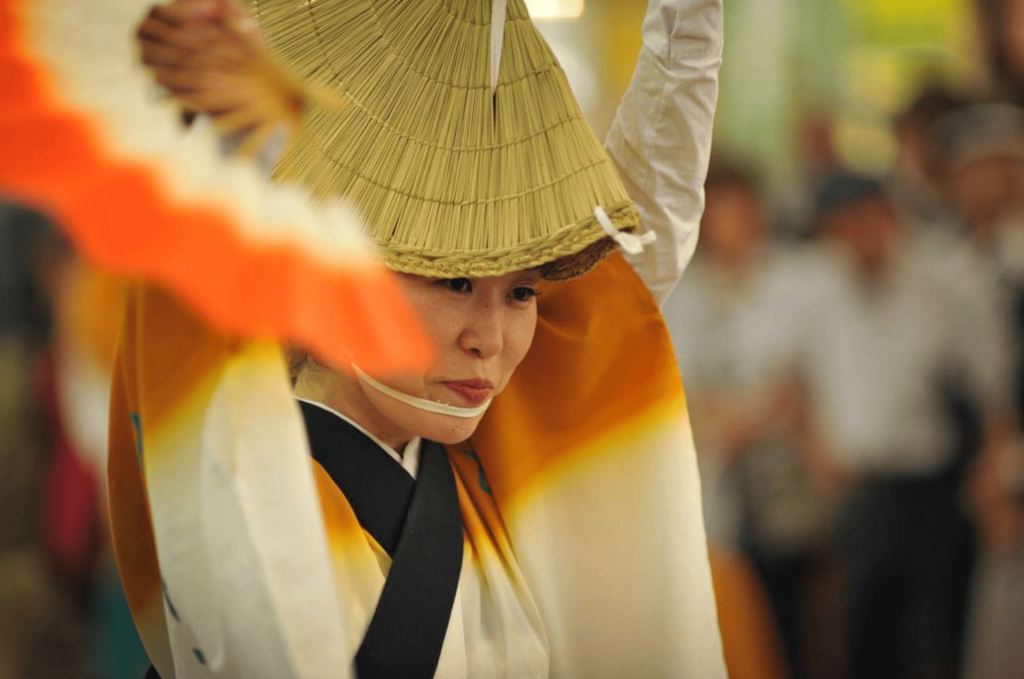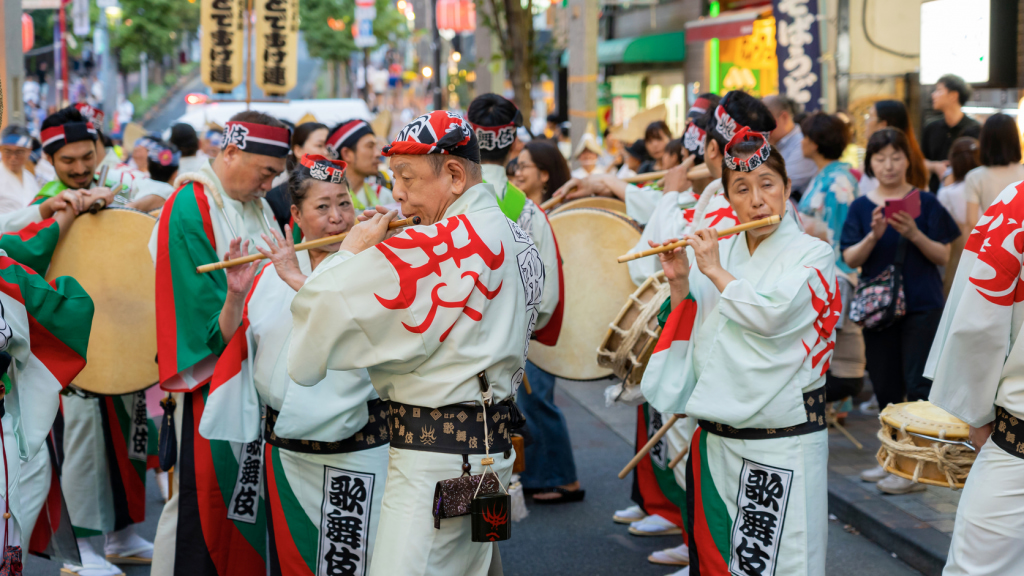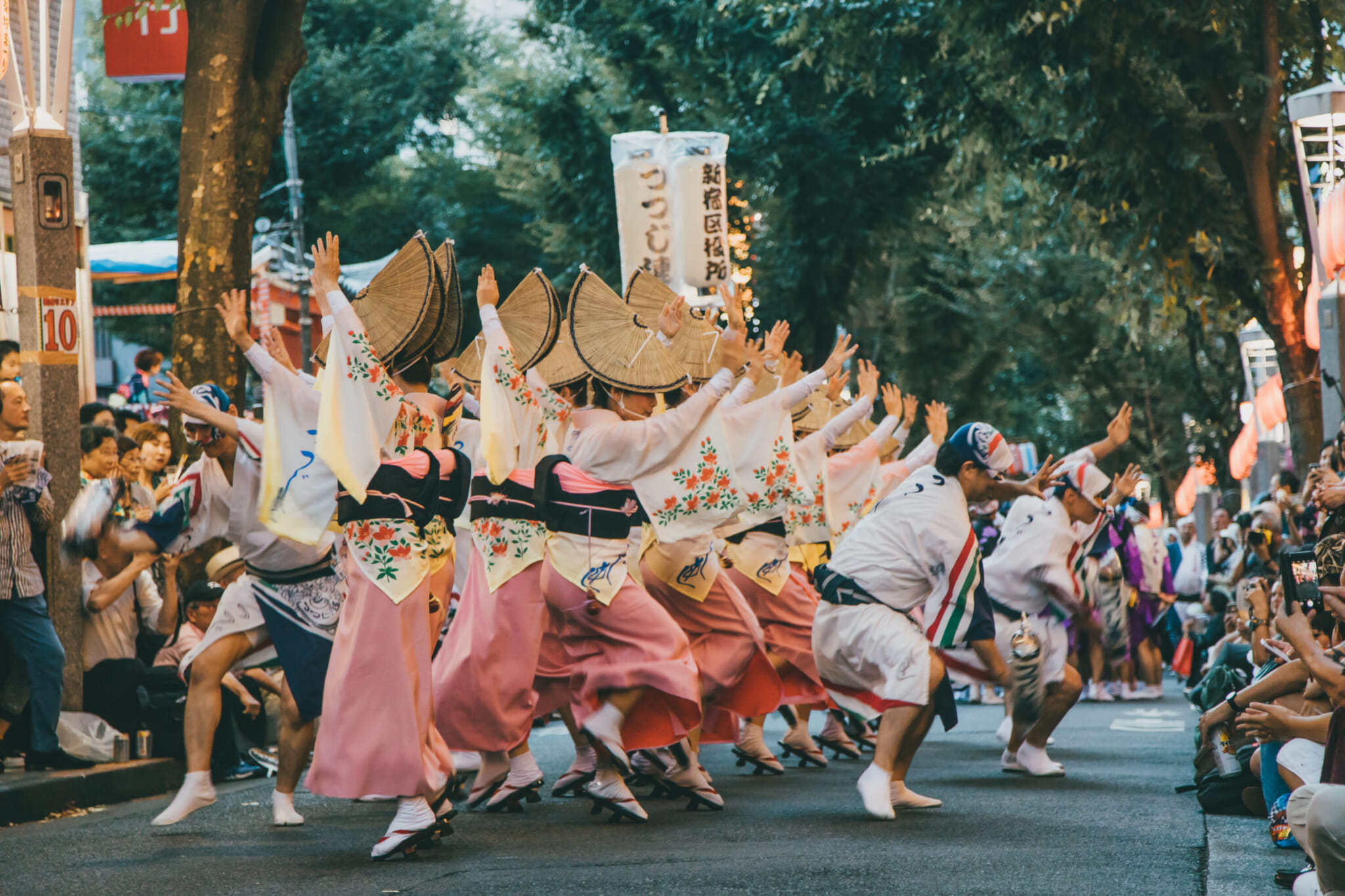The slow-moving, rhythmic dance of Awa Odori (a.k.a. Awa dance) is one of the defining features of many local Japanese festivals — groups of men and women in conical hats and tabi shoes, advancing slowly down the street to the sound of taiko drums and Japanese music. But what is the dance? Here’s our 101 for Awa Odori.
What Is Awa Odori?
Awa Odori is a type of Japanese festival dance, involving teams of Awa Odori dancers who will perform in the streets or on stage, moving in unison to a beat. The dance of Awa Odori (“odori” actually means “dance”) involves the team moving forwards and backwards with short, precise steps, holding up hands in correlation with whichever foot is in front.
During festival season, dancers will often be accompanied by a band playing traditional instruments, like taiko and shamisen. The dance can feel rather slow-paced compared to other styles like jazz and hip hop, as it moves in response to a dupe rhythm.
Band members will play the yoshikono throughout the dance. Yoshikono is a melody that originated in the Edo Period and came to be a part of Awa Odori some years later.
While members dance, they often chant or sing particular phrases. There are two main chants: One of the more recent ones is believed to come from Nagoya, with dancers shouting, “Yattosa! Yattosa!” The other chant invites everyone to join: “Odoru aho ni miru aho; onaji aho nara odoranya son son!” A rough translation is: “The dancers are fools, the watchers are fools, we’re all fools, so dance!” It is said to originate over 400 years ago, but that’s a story for the next section.

History of Awa Odori
Awa Odori as we know it comes from Tokushima Prefecture, formerly known as Awa Province, over 400 years ago. As with many traditional art forms, there are numerous theories as to its origin, but the general consensus is that the Awa Odori has its roots in the Bon Odori, which is danced as part of the Obon Festival, held mid-August to honor the spirits of one’s ancestors.
Awa Odori’s existence as an entity in its own right is thought to have started around the 1580s. (Tokushima Prefecture was previously called Awa, which is where its name comes from.) According to one account, it all began at a party to celebrate the construction of a new castle for the lord of the Awa domain. Revelers, having consumed a large amount of sake, began to dance with their arms and legs flailing, and the rest is history.
Nowadays, the Awa Odori isn’t limited to only Tokushima, but is performed all over the country. Aside from the Tokushima Awa Odori, there is a famous iteration of the festival in the Tokyo suburb of Koenji, and Awa Odori can be found in many summer festivals around Obon season in mid-August.
How to Do the Awa Odori
Performing the Awa Odori seems deceptively simple. Dancers place one foot diagonally to the other while advancing forward. As you do this, put out your correlating hand, palm out, fingers pointing upwards and the little finger at the front. In theory, it’s simple and easy to copy, but the training can be rigorous to ensure that the members don’t miss a beat. Additionally, the dance styles vary by gender; men traditionally take a lower stance, with their legs spread wider and bent more, and their steps tend to be more vigorous and energetic.
For anyone who lives in Japan and wants to join an Awa Odori festival as part of a team, there will probably be one in your local area.
Awa Odori Hats and Dress
Awa Odori dancers wear tabi shoes. They also wear yukata or happi, in colors to represent their dance team.
Women also wear iconic bamboo hats called toriogasa, which means “bird-scaring hat.” The hats were originally designed in various shapes, but over the years they morphed into one particularly distinctive style. Looking like an upside-down clam shell, they are perhaps the most recognizable characteristic of Awa Odori wear.

Famous Awa Odori Festivals
Without a doubt, the most famous Awa Odori festival takes place in Tokushima City from August 12–15. For those in Tokyo, the Koenji Awa Odori festival is one of the largest outside of Tokushima; the Shinagawa Shukuba Matsuri also features the dance prominently.
Next time you happen across a Japanese festival and catch the Awa Odori, you can sound smart as you impart nuggets of information from this article.









